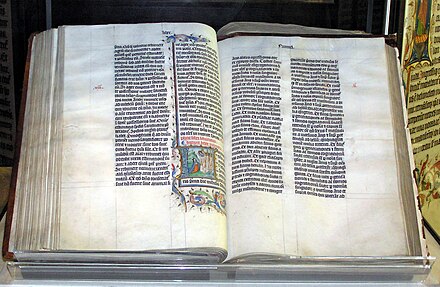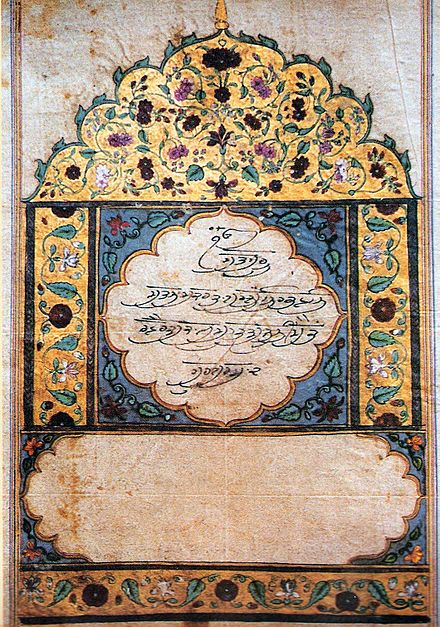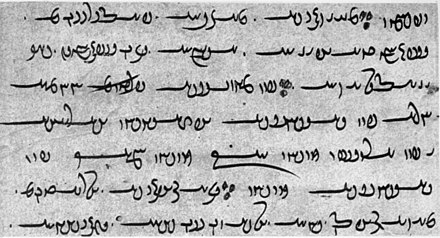Religious texts, also known asscripture, scriptures, holy writ, orholy books, are the texts which various religious traditions consider to besacred, or central to their religious tradition. Many religions and spiritualmovements believe that their sacred texts are divinely or supernaturallyrevealed or inspired.
History of religious texts
The oldest known religious texts are thePyramid Texts of Ancient Egypt that date to 2400-2300 BCE. The earliest form of the Phoenician alphabet found to date is the inscription on the sarcophagus of King Ahiram of Byblos(The Sumerian Temple Hymns) circa 1000 BCE.[1] The Epic of Gilgamesh fromSumer, with origins as early as 2150-2000 BCE,[2]:41–42 is also one of the earliest literary works that includes various mythological figures.[2]:41–42The Rigveda of Hinduism is proposed to have been composed between 1700–1100 BCE[3] making it possibly the world's oldest religious text still in use. The oldest portions of the ZoroastrianAvesta are believed to have been transmitted orally for centuries before they found written form, and although widely differing dates for Gathic Avestanhave been proposed, scholarly consensus floats at around 1000 - 600 BCE.[4][5]
The majority of scholars agree that theTorah's composition took place over centuries.[6] From the late 19th century there was a general consensus around the documentary hypothesis, which suggests that the five books were created c.450 BCE by combining four originally independent sources, known as the Jahwist, or J (about 900 BCE), theElohist, or E (about 800 BCE), theDeuteronomist, or D, (about 600 BCE), and the Priestly source, or P (about 500 BC).[7]
The first scripture printed for wide distribution to the masses was theDiamond Sutra, a Buddhist scripture, and is the earliest recorded example of a dated printed text, bearing the Chinese calendar date for 11 May 868 CE.[8]
Views
Attitudes to sacred texts differ. Some religions make written texts widely and freely available, while others hold that sacred secrets must remain hidden from all but the loyal and the initiate. Most religions promulgate policies defining the limits of the sacred texts and controlling or forbidding changes and additions. Some religions view their sacred texts as the "Word of God", often contending that the texts are inspired byGod and as such not open to alteration. Translations of texts may receive official blessing, but an original sacred language often has de facto, absolute or exclusive paramountcy. Some religions make texts available free or in subsidized form; others require payment and the strict observance of copyright.
References to scriptures profit from standardisation: the Guru Granth Sahib(of Sikhism) always appears with standardised page numbering while many other religions (including theAbrahamic religions and their offshoots) favour chapter and verse pointers.
Other terms
Terms like "Holy Writ", "Holy Scripture" or "Sacred Scripture" are often used by adherents to describe the canonical works of their religion to denote the text's importance, its status as divinerevelation, or, as in the case of many Christian groups, its complete inerrancy. Christianity is not alone in using this terminology to revere its sacred book; Islam holds the Qur'an in similar esteem, as does Hinduism the Vedas andBhagavad Gita and Buddhism thesutras.
Hierographology
Hierographology (Ancient Greek: ἱερός,hieros, "sacred" or "holy"; γραφή, graphe, "writing"; λόγος, logos, "word" or "reason") (archaically also 'hierology') is the study of sacred texts.
Increasingly, sacred texts of many cultures are studied within academic contexts, primarily to increase understanding of other cultures, whether ancient or contemporary. Sometimes this involves the extension of the principles of higher criticism to the texts of many faiths. It may also involve acomparative study of religious texts.
Sacred texts of various religions
Adidam
- The writings of Franklin Albert Jones a.k.a. Adi Da Love-Ananda Samraj
- Aletheon
- The Companions of the True Dawn Horse
- The Dawn Horse Testament
- Gnosticon
- The Heart of the Adi Dam Revelation
- Not-Two IS Peace
- Pneumaton
- Transcendental Realism
Aetherius Society
- Contacts with the Gods from Space
Ásatrú
Atenism
Ayyavazhi
- The Akilathirattu Ammanai
- The Arul Nool
Aztec religion
- The Borgia Group codices
Bahá'í Faith
Main article: Bahá'í literature
Books by Bahá'u'lláh
- The Four Valleys (1857 version)
- The Seven Valleys (1860 version)
- The Hidden Words of Bahá’u’lláh (in Arabic 1857)
- The Hidden Words of Bahá’u’lláh (in Persian 1857)
- Gems of Divine Mysteries (ca 1859)
- The Book of Certitude (partly in Persian and partly in Arabic 1861)
- Summons of the Lord of Hosts (ca 1868)
- Tabernacle of Unity (ca 1870)
- Kitáb-i-Aqdas (Completed 1873)
- Tablets of Bahá’u’lláh Revealed After the Kitáb-i-Aqdas (written until 1892)
- Epistle to the Son of the Wolf (ca 1890)
- Gleanings from the Writings of Bahá’u’lláh (compilation chosen by Shoghi Effendi of Bahá'u'lláh's writings, 1853 to 1892)
Bön
Buddhism

Ancient style of scripture used for the Pāli Canon
See also: Buddhist texts
- Theravada Buddhism
- The Tipitaka or Pāli Canon
- Vinaya Pitaka
- Sutta Pitaka
- Digha Nikaya, the "long" discourses.
- Majjhima Nikaya, the "middle-length" discourses.
- Samyutta Nikaya, the "connected" discourses.
- Anguttara Nikaya, the "numerical" discourses.
- Khuddaka Nikaya, the "minor collection".
- Abhidhamma Pitaka
- East Asian Mahayana

The Chinese Diamond Sutra, the oldest known datedprinted book in the world, printed in the 9th year of Xiantong Era of the Tang Dynasty, or 868 CE. British Library.
- The Chinese Buddhist Tripiṭaka, including
- Diamond Sutra and the Heart Sutra
- Shurangama Sutra and itsShurangama Mantra
- Pure Land Buddhism
- Infinite Life Sutra
- Amitabha Sutra
- Contemplation Sutra
- other Pure Land Sutras
- Tiantai, Tendai, and Nichiren
- Shingon
Cheondoism
Christianity

Christian Bible, 1407 handwritten copy
- The Bible (the Old Testament and New Testament)
- For Protestantism, this is the 66-book canon - the Jewish Tanakh of 24 books divided differently (into 39 books) and the universal 27-book New Testament.
- For Catholicism, this includes sevendeuterocanonical books in the Old Testament for a total of 73 books, called the Canon of Trent (in versions of the Latin Vulgate, 3 Esdras and 4 Esdras are included in an appendix, but considered non-canonical).
- For the Eastern Orthodox Church, this includes the anagignoskomena, which consist of the Catholic deuterocanon, plus 3 Maccabees,Psalm 151, the Prayer of Manasseh, and 3 Esdras. 4 Maccabees is considered to be canonical by theGeorgian Orthodox Church.[10]
- The Ethiopian Orthodox Tewahedo Church (and its offspring, the Eritrean Orthodox Church) adds various additional books depending on the specific enumeration of the canon (see Ethiopian Biblical canon), but always includes 4 Esdras, the Book of Jubilees, 1 Enoch, 4 Baruch, and 1, 2, and 3 Meqabyan (no relation to the Books of Maccabees).
- Some Syriac churches accept theLetter of Baruch as scripture.

The Bible (left) and Science and Health with Key to the Scriptures (right) serve as the pastor of the Christian Science church.
- The Bible
- Science and Health with Key to the Scriptures by Mary Baker Eddy. This textbook, along with the Bible, serves as the permanent "impersonal pastor" of the church.
- Nag Hammadi library and otherGnostic texts (not from the Bible)
- Some books of the Old Testament andNew Testament
- Only the Gospel of Marcion and selected Pauline epistles accepted

Cover page of The Book of Mormon from an original 1830 edition, by Joseph Smith, Jr.
(Image from the U.S. Library of Congress Rare Book and Special Collections Division.)
(Image from the U.S. Library of Congress Rare Book and Special Collections Division.)
- The Bible (The New World Translation of the Holy Scriptures is their preferred translation.)
Further information: Standard Works and Biblical canon § Latter Day Saint canons
- The Bible
- The Church of Jesus Christ of Latter-day Saints (LDS Church) uses the LDS edition of the King James Bible for English-speaking members; other versions are used in non-English speaking countries.
- The Community of Christ (RLDS) uses the Joseph Smith Translation, which it calls the Inspired Version, as well as updated modern translations.
- The Book of Mormon
- The Pearl of Great Price
- The Doctrine and Covenants
- There are significant differences in content and section numbering between the Doctrine and Covenants used by the Community of Christ(RLDS) and the LDS Church.
- Other, smaller branches of Latter Day Saints include other scriptures, such as the Book of the Law of the Lord used by the Church of Jesus Christ of Latter Day Saints (Strangite) or The Word of the Lord used by Fettingite branches.
- Native American Church (Christian-leaning factions)
- See below.
- The Bible
- The writings of Ellen White are held to an elevated status, though not equal with the Bible, as she is considered to have been an inspired prophetess.
Confucianism
- The Five Classics
- The Four Books
- The Thirteen Classics
Discordianism
Druidism
- The Mabinogion
- Lebor Gabála Érenn (The Book of Invasions)
Druze
- Rasa'il al-hikmah (Epistles of Wisdom)
Ancient Egyptian religion

Pyramid texts from Teti I's pyramid.
- Old Kingdom
- First Intermediate Period and Middle Kingdom
- Second Intermediate Period
Etruscan religion

The Cippus of Perugia, 3rd or 2nd century BCE
Ancient Greece
Hermeticism
- Hermetica, Kybalion, Emerald Tablet and associated writings
Hinduism
Main article: Hindu texts
- Itihāsas
- Mahābhārata (including theBhagavad Gita)
- Ramayana
- Puranas (List)
- Tantras
- Sutras (List)
- Stotras
- Ashtavakra Gita
- Gherand Samhita
- Gita Govinda
- Hatha Yoga Pradipika
- Yoga Vasistha
- In Vedanta (Uttar Mimamsa)
- In Yoga
- In Samkhya
- Samkhya Sutras of Kapila
- In Nyaya
- Nyāya Sūtras of Gautama
- In Vaisheshika
- Vaisheshika Sutras of Kanada
- In Vaishnavism
- Vaikhanasa Samhitas
- Pancaratra Samhitas
- In Saktism
- Sakta Tantras
- 64 Bhairavagamas
- 28 Shaiva Agamas
- Shiva Sutras of Vasugupta
- Vijnana Bhairava Tantra
- Pashupata Sutras of Lakulish
- Panchartha-bhashya of Kaundinya (a commentary on the Pashupata Sutras)
- Ganakarika
- Ratnatika of Bhasarvajna
- Krishna-karnamrita
- Chaitanya Bhagavata
- Chaitanya Charitamrita
- Prema-bhakti-candrika
- Hari-bhakti-vilasa
- In Lingayatism
- Siddhanta Shikhamani
- Vachana sahitya
- Mantra Gopya
- Shoonya Sampadane
- 28 Agamas
- Karana Hasuge
- Basava purana
- In Kabir Panth
- poems of Kabir
- In Dadu Panth
- poems of Dadu
Islam

11th Century North African Qur'an in the British Museum
Main article: Islamic holy books
- The Quran (also referred to as Kuran, Koran, Qur’ān, Coran or al-Qur’ān) – Four books considered to be revealed and mentioned by name in the Qur'an are the Quran (revealed to Muhammad), Tawrat(revealed to Moses), the Zabur (revealed to David) and the Injil (Gospel) (revealed to Jesus).
- Hadith, reports of the deeds and sayings of Muhammad.
Jainism
Main article: Jain Agamas
- 11 Angas
- Secondary
- 12 Upangas, 4 Mula-sutras, 6 Cheda-sutras, 2 Culika-sutras, 10 Prakirnakas
- Secondary
- Karmaprabhrita, also calledSatkhandagama
- Kashayaprabhrita
- Nonsectarian/Nonspecific
- Jina Vijaya
- Tattvartha Sutra
- GandhaHasti Mahabhashya (authoritative and oldest commentary on the Tattvartha Sutra)
Judaism

A Sefer Torah opened for liturgical use in asynagogue service
- Rabbinic Judaism
- See also: Rabbinic literature
- The Tanakh i.e. Hebrew Bible
- The Talmud
- Kabbalism
- The Tanakh
- The Tanakh with several Jewish apocrypha
Mandaeanism
Manichaeism
- The Evangelion (Greek: Εὐαγγέλιον, meaning roughly "good news"). Also known as the Gospel of Mani and The Living Gospel
- the Treasure of Life
- the Pragmateia (Greek: πραγματεία)
- the Book of Mysteries
- The Book of Giants
- the Epistles
- the Psalms and Prayers. A CopticManichaean Psalter, discovered in Egypt in the early 1900s, was edited and published by Charles Allberry from Manichaean manuscripts in the Chester Beatty collection and in the Berlin Academy, 1938–9.
- The Shabuhragan
- The Arzhang
- The Kephalaia (Greek: Κεφάλαια), "Discourses", found in Coptic translation.
Maya religion
- The Popol Vuh
- the Dresden Codex
- the Madrid Codex
- the Paris Codex
- countless destroyed codices
Meher Baba
Native American Church
- The Bible (among Christian-leaning factions only)
New Age religions
Various New Age religions may regard any of the following texts as inspired:
Orphism
Raëlism
- The writings of Raël aka Claude Vorilhon
- Intelligent Design: Message from the Designers
- Sensual Meditation
- Yes to Human Cloning
Rastafari movement
- The Bible (Ethiopian Orthodox canon)
- the Holy Piby
- the Kebra Nagast
- The speeches and writings of Haile Selassie I (including his autobiographyMy Life and Ethiopia's Progress)
- Royal Parchment Scroll of Black Supremacy
Ravidassia

Amritbani Satguru Ravidass Ji Ki-Holy Book of Ravidassia Religion
Samaritanism
See also: Samaritans § Religious texts
- The Samaritan Torah
Satanism
Science of Mind
- The Science of Mind by Ernest Holmes
Scientology
Shinto
- The Kojiki
- The Rikkokushi, which includes theNihon Shoki and the Shoku Nihongi
- The Fudoki
- The Jinnō Shōtōki
- The Kujiki
Sikhism

Illuminated Guru Granth folio with Mul Mantar(basic religion mantra) with signature of Guru Gobind Singh.
Main article: Sikh scriptures
- The Guru Granth Sahib
- The Dasam Granth
Spiritism
Sumerian
- The Barton Cylinder
Swedenborgianism
- The Bible (several books omitted)
- The works of Emanuel Swedenborg(not considered equal to the Bible)
- The General Church
- The Bible (several books omitted)
- The works of Emanuel Swedenborg(considered equal to the Bible)
Taoism
Tenrikyo
Thelema
- The Holy Books of Thelema, especially The Book of the Law
Unarius Academy of Science
- The Voice of Venus
Unification Church
- The Divine Principle
- The Bible as illuminated by more recent revelation
Urantianism
Wicca
Yârsân
Yazidi
- Yazidi Black Book
- Yazidi Book of Revelation
- The true core texts of the Yazidi religion that exist today are the hymns, known as qawls.
Yorùbá
- Odù Ifá
- Jaap Verduijn's Odu Ifa Collection
Zoroastrianism

Yasna 28.1 (Bodleian MS J2)
- Primary religious texts, that is, theAvesta collection:
- The Yasna, the primary liturgical collection, includes the Gathas.
- The Visperad, a collection of supplements to the Yasna.
- The Yashts, hymns in honor of the divinities.
- The Vendidad, describes the various forms of evil spirits and ways to confound them.
- shorter texts and prayers, theYashts the five Nyaishes ("worship, praise"), the Sirozeh and the Afringans(blessings).
- There are some 60 secondary religious texts, none of which are considered scripture. The most important of these are:
- The Denkard (middle Persian, 'Acts of Religion'),
- The Bundahishn, (middle Persian, 'Primordial Creation')
- The Menog-i Khrad, (middle Persian, 'Spirit of Wisdom')
- The Arda Viraf Namak (middle Persian, 'The Book of Arda Viraf')
- The Sad-dar (modern Persian, 'Hundred Doors', or 'Hundred Chapters')
- The Rivayats, 15th-18th century correspondence on religious issues
- For general use by the laity:
- The Zend (lit. commentaries), various commentaries on and translations of the Avesta.
- The Khordeh Avesta, Zoroastrian prayer book for lay people from the Avesta.
See also
References
Tap to expand

No comments:
Post a Comment